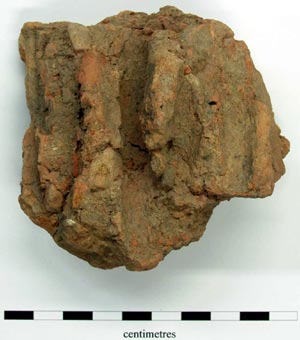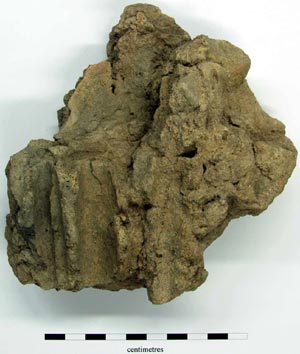Blue Bridge Lane
&
Fishergate House
Printed from the APC web site: navigation and non-essential images removed.
Please view on-line for full content (URL at end of document).
Approximatley 20kg of daub were recovered from various features at Blue Bridge Lane, York. The fabric of the daub recovered was relatively homogenous, suggesting that all of the material came from one building or a series of buildings of the same period. Much of the material was fragmentary, but several examples survived in a size sufficient to show clear impressions, usually of parts of the structural rods used support the panels of the building. The remains were compared with the middle Saxon site found in excavations at the Royal Opera House, London (Goffin 2003, 214-5), where substantial quantities of daub from a similar period were discovered.
Composition
In the better preserved fragments the composition of the mud is clear with sand, quartzite and small gravel inclusions. The tempering of the mud with organic material can also be ascertained with the impressions of straw, grass and husk or seed impressions left on the surface of some of the fragments.
Structural elements
The larger fragments of surviving daub frequently have evidence of the structural rods used to fill panels and provide support for the daub. The rods used varied in diameter, usually measuring between 12mm and 15mm and were spaced unevenly across the panels. This relatively small size suggests that these were not the principal rods used to provide structural support but some of the smaller elements woven to provide a structure to adhere the daub too. This was certainly the case in the more substantial fragments of daub found in the middle Saxon settlement on the site of the Royal Opera House where thinner rods (between 13mm and 16mm) contrasted with larger principal rods of between 20mm -35mm (Malcolm and Bowsher 2003, 152). Impressions of these larger principal rods have not survived on the Blue Bridge Lane site (Plate 17 and 18).
 |
 |
| Plate 17 | Plate 18 |
In places the pattern of the bark had been preserved imprinted on the mud of the daub. This, and the variation in the size of the rods used, suggests that only a basic preparation of the wood was carried out before its use in the construction. None of the surviving fragments had evidence of the smooth surface or limewash dressing that may have indicated an internal surface.
The vast majority of the daub was found in Period 3 features (Table 1); the remainder of the daub is probably redistributed from Period 3 features. There is a negligible amount of daub from a Period 2 feature, which may be associated with an earlier structure on the site or could be intrusive. Period 4 pits F216F and F219F also contained daub; the former also contained a large quantity, which was poorly preserved and amorphous, but nonetheless may represent the superstructure of a grain-drier, since it was associated with carbonised grain and seeds.
| Feature | Period | Weight (g) |
|---|---|---|
| 13B | 3 | 45.7 |
| 43B | 2 | 87.1 |
| 64F | 3 | 104.2 |
| 88B | 9 | 6.0 |
| 162B | 9 | 63.2 |
| 164B | 3 | 96.5 |
| 178B | 8 | 267.2 |
| 216F | 4 | 2114.6 |
| 219F | 4 | 135.1 |
| 219B | 8 | 38.9 |
| 225B | 3 | 236.0 |
| 240B | 7 | 38.3 |
| 241B | 3 | 23.6 |
| 245B | 8 | 9.2 |
| 269B | 8 | 5.7 |
| 273B | 3 | 111.1 |
| 351B | 3 | 18.4 |
| 353B | 3 | 164.1 |
| 359B | 3 | 7.0 |
| 381B | 3 | 15880.6 |
| 401B | 7 | 4.6 |
| 408B | 3 | 255.1 |
| 412B | 3 | 11.1 |
| 413B | 3 | 119.6 |
| 442B | 3 | 36.4 |
| 460B | 4 | 177.7 |
| 475B | 6 | 10.1 |
| 546B | 3 | 16.6 |
| 569B | 7 | 26.3 |
| Total | 20110.0 |
apc > monographs > blue bridge lane & fishergate house > artefacts & environmental > building materials